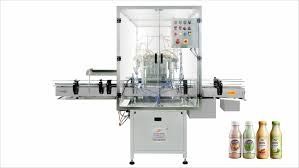In today’s fast-paced production environment, bottle filling equipment plays a crucial role in ensuring efficiency, precision, and hygiene. From water and soft drinks to pharmaceutical syrups and industrial chemicals, these machines automate the process of filling liquids into bottles, reducing human error and maximizing productivity.
Liquid filling machines are widely used in food and beverage industries, cosmetics, and pharmaceutical manufacturing where accuracy and contamination control are essential. Advanced automatic bottle fillers help maintain uniform fill levels while minimizing waste, ensuring each product meets quality and safety standards.
How Do Bottle Filling Machines Work?
The fundamental operation of a bottle filling machine involves several coordinated steps:
-
Bottle Feeding: Empty bottles are aligned and conveyed into the filling station.
-
Filling Process: Depending on the liquid type and viscosity, nozzles dispense the correct volume.
-
Capping and Sealing: After filling, bottles are sealed to prevent leakage or contamination.
-
Labeling and Packaging: Finished products are labeled and packed for distribution.
These steps are automated in industrial filling systems, allowing high-speed production with consistent accuracy and minimal downtime.
Types of Liquid Filling Machines
| Machine Type | Filling Principle | Ideal for |
|---|---|---|
| Gravity Filling Machine | Uses gravity to fill thin, free-flowing liquids. | Water, juices, alcohol |
| Piston Filling Machine | Employs pistons to push liquids with high viscosity. | Creams, syrups, sauces |
| Vacuum Filling Machine | Uses vacuum pressure for precise fill control. | Perfumes, oils |
| Overflow Filling Machine | Ensures consistent fill levels by overflow mechanism. | Transparent bottles, beverages |
| Pump Filling Machine | Uses pumps to fill a fixed volume per cycle. | Detergents, lotions |
| Automatic Bottle Filler | Fully automated system with conveyors and sensors. | Large-scale beverage and chemical plants |
Each type is selected based on liquid properties (viscosity, foaming, temperature) and production scale.
Key Components of Bottle Filling Equipment
-
Conveyor System: Transports bottles through the filling, capping, and labeling stages.
-
Filling Nozzles: Dispense precise liquid volumes into containers.
-
Control Panel: Programmable system for setting fill volumes and speeds.
-
Sensors and Valves: Ensure accurate operation and detect missing or misaligned bottles.
-
Capping Unit: Secures caps automatically after filling.
-
Cleaning System: Maintains hygiene, especially for food and pharmaceutical use.
Applications of Bottle Filling Equipment
Bottle filling equipment is used across multiple industries due to its precision, speed, and reliability.
1. Beverage Industry:
Used for filling water, juices, soft drinks, wine, and beer in various container types.
2. Pharmaceutical Sector:
Ensures accurate dosage for syrups, tonics, and liquid medicines under sterile conditions.
3. Cosmetics and Personal Care:
Used to fill lotions, shampoos, and perfumes with uniform volume and minimal spillage.
4. Chemicals and Lubricants:
Handles solvents, acids, and oils safely through corrosion-resistant materials.
5. Food and Dairy:
Fills sauces, dressings, milk, and flavored drinks maintaining hygiene and shelf life.
Advantages of Using Industrial Filling Systems
-
Precision Filling: Reduces overfilling and underfilling errors.
-
Speed and Efficiency: High output with minimal operator intervention.
-
Versatility: Adaptable for different bottle sizes and liquid viscosities.
-
Hygienic Design: Stainless steel construction suitable for food and pharmaceuticals.
-
Automation Integration: Seamlessly connects with labeling, capping, and packaging lines.
-
Reduced Labor Costs: Automation minimizes manual handling.
Automatic Bottle Filling Machines: Features and Innovations
Modern automatic bottle fillers come equipped with smart controls and sensors that enhance production performance.
Key Features Include:
-
Touchscreen interfaces for easy parameter control.
-
Servo-driven filling nozzles for volume accuracy.
-
Quick-change components for different bottle formats.
-
Self-cleaning and CIP (Clean-In-Place) systems for hygiene compliance.
-
Integration with IoT-based monitoring for predictive maintenance.
Beverage Filling Machines: Specialized Solutions
In the beverage industry, precision and speed are paramount. Beverage filling machines are designed to handle both carbonated and non-carbonated drinks efficiently.
Common Configurations:
-
Rotary filling systems for high-volume output.
-
Isobaric fillers for carbonated drinks.
-
Aseptic filling machines for milk, juices, and sensitive beverages.
These systems maintain consistent temperature control, foam management, and bottle sterilization to ensure top product quality.
Trends in Bottle Filling Equipment (2025 and Beyond)
-
AI and Vision Systems: For real-time defect detection and line optimization.
-
Sustainable Filling: Reduced water usage and eco-friendly packaging materials.
-
Energy-Efficient Motors: To lower operational costs and carbon footprint.
-
Robotic Integration: Automating bottle sorting and palletizing stages.
-
Digital Twins: Simulating production processes to predict and prevent errors.
Tips for Choosing the Right Filling Machine
-
Assess liquid viscosity and bottle material (glass, PET, HDPE).
-
Determine production speed (bottles per minute).
-
Choose between semi-automatic and fully automatic systems.
-
Consider cleaning requirements for food-grade applications.
-
Evaluate supplier support, warranty, and spare parts availability.
Conclusion
Bottle filling equipment is a cornerstone of industrial manufacturing — enabling precision, consistency, and scalability across diverse sectors. Whether for beverages, pharmaceuticals, or cosmetics, choosing the right liquid filling machine can significantly boost production efficiency and product quality. With innovations like AI-driven control systems and energy-efficient automation, the future of industrial filling systems is smarter, cleaner, and faster.